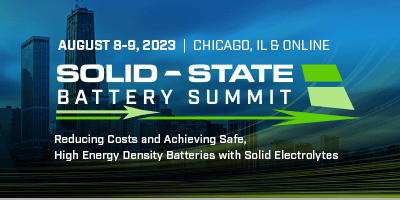2023 Poster Presentations
P01: Composite Polymer Electrolytes for High Performance Li Metal Batteries, Presented by Chen L., Argonne National Laboratory
P02: Development of LLZO-Nanofiber Composite Membranes for Solid Electrolyte Applications, Presented by Yuepeng Z., Argonne National Laboratory
P03: Safety Standards and Solid State Batteries: Is Understanding Lithium-Ion Technology Enough?, Presented by Lucy B., Exponent
P04: ALD Nanocoatings Solve Product and Process Challenges for Solid-State Batteries, Presented by James T., Forge Nano
P05: Probing Degradation of Battery Cell Components with Optical and Electrical Tools, Presented by Nolan W., HORIBA Scientific
P06: Future Generations of Solid-State Batteries from Hydro-Quebec: Breakthroughs and Progress, Presented by Benoit F., Hydro-Quebec
P07: Lithium Ion Batteries and Fuel Cell Processes, Presented by Robert V., IKA Works, Inc.
P08: Tailored Phase Transformations to Significantly Enhance Toughness of Solid State Conductors, Presented by David D., Montana State University
P09: Pilot-Scale Solid Electrolyte Powder and Membrane Development, Presented by Amanda G., Nexceris, LLC
P10: Zero Defect Initiatives for Battery Manufacturing, Presented by Prasad B., Onto Innovation
P11: Gaining Insights into Battery Material Performance with Analytical Techniques, Presented by Ryan S., PerkinElmer
P12: Synthesis and Evaluation of LPSCI Solid Electrolyte with High Air-Stability and Ionic Conductivity, Presented by Gwangseok O., POSCO Holdings
P13: ASSB Three Electrode Design for Detecting C-Rate Limit of Graphite Anode, Presented by Kewei L., Schaeffler Transmission Systems
P14: High-Voltage, High-Energy, High-Power Solid-State Li-Ion Batteries (SSLiB) for EV Applications, Presented by Timothy L., Solid Energies, Inc.
P15: Multifaceted Doping to Advance the Conductivity and Stability of Li7P2S8I Solid Electrolyte for All-Solid-State Lithium Batteries, Presented by Kwang Sun R., University of Ulsan
P16: Safety Standards for Solid-State Batteries: A Pack-Level Perspective, Presented by Wahid Z., Exponent









